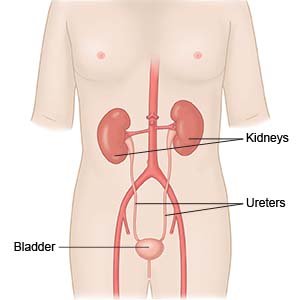Nephrostomy Tube Insertion
Medically reviewed by Drugs.com. Last updated on Feb 9, 2025.
What do I need to know about nephrostomy tube insertion?
A nephrostomy tube is a catheter (thin plastic tube) that is inserted through your skin and into your kidney. The nephrostomy tube is placed to drain urine from your kidney into a collecting bag outside your body. You may need one tube for each kidney.
 |
How do I prepare for the procedure?
- Your healthcare provider will tell you how to prepare. He or she may tell you not to eat or drink anything after midnight on the day of the procedure. Arrange to have someone drive you home after you are discharged.
- Tell your provider about all medicines you currently take. He or she will tell you if you need to stop any medicine for the procedure, and when to stop. He or she will tell you which medicines to take or not take on the day of your procedure.
- You may need antibiotic medicine before your procedure to prevent or treat a bacterial infection. Tell your provider if you had an allergic reaction to antibiotics.
- You may need blood tests, an ECG, urine tests, x-rays, or other tests before your procedure.
- You will need to clean out your bowel to get ready for this procedure. You may need to use medicine called an enema. You may need to drink bowel prep medicine. Your provider will tell you when and how to do bowel prep.
What will happen during the procedure?
- You will be lying on your stomach for this procedure. Ultrasound or x-ray pictures may be used during the procedure to guide a needle into your kidney. Your healthcare provider will insert a needle into your lower back. When the needle reaches your kidney, small amounts of urine will be collected and sent for tests. Your provider will inject contrast liquid, gas, or air to help him or her see your kidney more clearly.
- A guide wire and catheter may be used to dilate (widen) the area where the needle will be passed through. A nephrostomy tube will be inserted and pushed slowly through this area until it reaches your kidney. The tube will be secured with stitches, an attachment device, or a balloon. The tube will come out of your skin and be connected to a drainage bag outside your body.
What should I expect after the procedure?
You will be taken to a room where you can rest. Healthcare providers will monitor you closely for any problems. When your healthcare provider sees that you are okay, you may be able to go home. If you are staying in the hospital, you will be taken to your hospital room.
- The urine drainage bag will be checked for blood. It is normal to have some blood in your urine for 1 or 2 days after you have a nephrostomy tube placed. The amount of urine in the bag will also be checked to make sure that the tube is draining all of the urine from your kidney.
- Medicine may be given for pain.
- Tests will be done to check for any problems after your procedure.
What are the risks of nephrostomy tube insertion?
You may develop an infection or bleed more than expected. Nerves, tissues, and other parts of your kidney may be damaged. Other organs near your kidney may be damaged during the procedure. Air, fluids, blood, or urine may get into your abdomen. The catheter may move out of place, get blocked, or not work as it should.
Care Agreement
You have the right to help plan your care. Learn about your health condition and how it may be treated. Discuss treatment options with your healthcare providers to decide what care you want to receive. You always have the right to refuse treatment. The above information is an educational aid only. It is not intended as medical advice for individual conditions or treatments. Talk to your doctor, nurse or pharmacist before following any medical regimen to see if it is safe and effective for you.© Copyright Merative 2025 Information is for End User's use only and may not be sold, redistributed or otherwise used for commercial purposes.
Further information
Always consult your healthcare provider to ensure the information displayed on this page applies to your personal circumstances.
